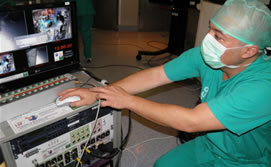This is a unique technology that incorporates the necessary equipment to analyze, view and record the images produced by various systems used in surgical practices into a reduced-size, portable kit.
An interdisciplinary team, including engineers from the University of Seville and specialists from the University Hospital Virgen del Rocío, have presented QIP: Quirófano Inteligente Portátil (smart portable operating room). This is a reduced-size system which incorporates the management, viewing and analysis of surgical images. The proprietary underlying technology used, called Sagiq, feeds on information generated by the different equipment commonly found in operating rooms, such as endoscopes, ultrasounds, respirators, field cameras and neuronavigators, among others.
Doctors Guillermo Artiñolo, director of the Genetics, Reproduction and Fetal Medicine Unit at the University Hospital Virgen del Rocío in Seville, and Javier Márquez, head of Neurosurgery, together with Emilio Gómez, director of the University of Seville’s Interdisciplinary Physics group, highlight that this system has been used in more than 350 enormously complex neurosurgeries for children; these included respiratory arrest, tumors at the base of the skull and operations on valves, as well as 15 fetal surgeries and in one instance simultaneously in three interconnected operating rooms during training courses.
 It has taken seven years to develop this innovative technology, which miniaturizes equipment into one small mobile system that until now required remodeling work and cost over €2 million. The system has been patented by the Andalusia Health Service and will be commercially available as of 2012 from the Spanish healthcare multinational Navimetric. Among the company’s plans are to equip the QIP with a neuronavigator, that suggests optimal surgical approaches for doctors.
It has taken seven years to develop this innovative technology, which miniaturizes equipment into one small mobile system that until now required remodeling work and cost over €2 million. The system has been patented by the Andalusia Health Service and will be commercially available as of 2012 from the Spanish healthcare multinational Navimetric. Among the company’s plans are to equip the QIP with a neuronavigator, that suggests optimal surgical approaches for doctors.
